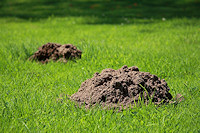Tips for growing a healthy lawn
Growing and maintaining a healthy, happy lawn is not difficult if you follow some simple rules.
Lawns can come under attack from many different angles; being dug up or poisoned, overrun with weeds or starved of food or water are just a few of the dangers your lawn will face every day and the UK weather doesn't help. There are a few things you can do to protect your lawn and help it grow and flourish.
Mowing your lawn properly and regularly is not just important for keeping it looking neat; it also helps keep it healthy. You need to cut your grass regularly the whole time it is growing, usually from early spring to autumn and aim to keep it around an inch and a half (4cm) long. Allow it to grow a little longer on areas that get walked on a lot or in the shade to give it a bit more strength. If in doubt stay on the longer side as a too short lawn is open to damage and attack by weeds and moss.
Rake the lawn with a springy rake to remove dead grass and moss and use a fork or mechanical aerator to spike the ground and increase airflow and drainage, helping to prevent moss. Remove dead leaves from the lawn in autumn as they will smother the grass and starve it of daylight.
There are lots of treatments that you can apply to lawns to keep them in tip top condition. Lawn feed in the spring replaces the nutrients that are being quickly used up by the fast growing lawn and weed killers will get rid of moss and weeds; apply this a couple of weeks before scarifying (raking) and the dead moss will come out easily.
If your lawn is looking a bit patchy, scatter seed to fill in the gaps; spring and autumn are the best times to do this as you won't need to water the new growth as much as you would do in summer.
Top dressing involves spreading sand or soil mixtures onto your lawn to even out any divots with the extra advantage of improving the drainage; do this in autumn for the best results. Leatherjackets and Chafer Grubs are the most common lawn pests, if you see yellowing patches of lawn check the roots for these grubs and apply a nematode control to get rid of them.
 Moles make unsightly hills on your lawn and are difficult to get rid of once they have moved in, so if you see signs of moles nearby try one of the many deterrents available such as garlic or sonic repellents. Ants also make messy hills on your lawn, but are easier than moles to chase away; just use a nematode treatment which chases the ants from their colonies. Once they are gone you can spread the anthill out to remove it.
Moles make unsightly hills on your lawn and are difficult to get rid of once they have moved in, so if you see signs of moles nearby try one of the many deterrents available such as garlic or sonic repellents. Ants also make messy hills on your lawn, but are easier than moles to chase away; just use a nematode treatment which chases the ants from their colonies. Once they are gone you can spread the anthill out to remove it.
A tidy green lawn is a beautiful sight and a well looked after one will recover well from a hosepipe ban even if it looks a bit sad during the drought. With regular maintenance and a bit of occasional effort you should be able to create and keep a near perfect looking lawn without having to resort to artificial grass.





